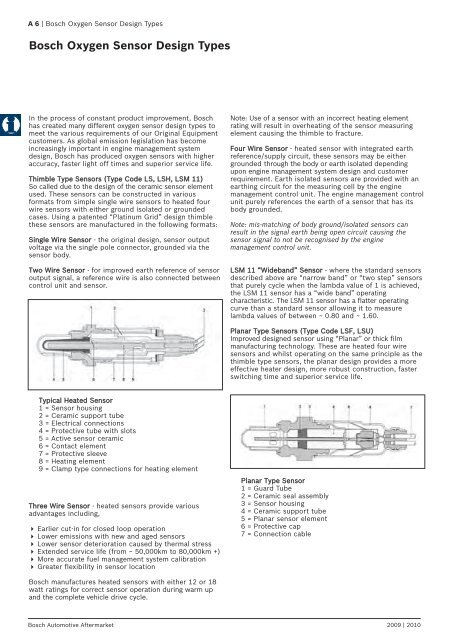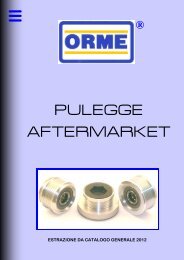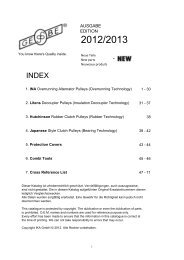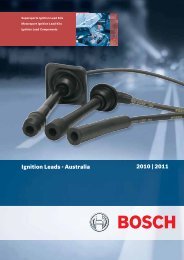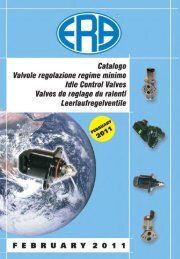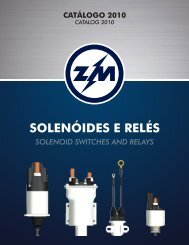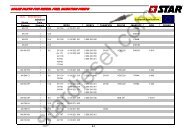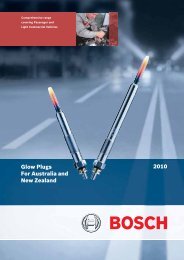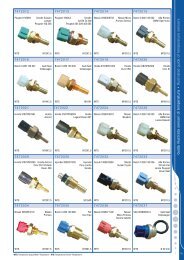Lambda sensors
Lambda sensors
Lambda sensors
- No tags were found...
You also want an ePaper? Increase the reach of your titles
YUMPU automatically turns print PDFs into web optimized ePapers that Google loves.
A 6A 6 | Bosch Oxygen Sensor Design TypesBosch Oxygen Sensor Design TypesIn the process of constant product improvement, Boschhas created many different oxygen sensor design types tomeet the various requirements of our Original Equipmentcustomers. As global emission legislation has becomeincreasingly important in engine management systemdesign, Bosch has produced oxygen <strong>sensors</strong> with higheraccuracy, faster light off times and superior service life.Thimble Type Sensors (Type Code LS, LSH, LSM 11)So called due to the design of the ceramic sensor elementused. These <strong>sensors</strong> can be constructed in variousformats from simple single wire <strong>sensors</strong> to heated fourwire <strong>sensors</strong> with either ground isolated or groundedcases. Using a patented “Platinum Grid” design thimblethese <strong>sensors</strong> are manufactured in the following formats:Single Wire Sensor - the original design, sensor outputvoltage via the single pole connector, grounded via thesensor body.Two Wire Sensor - for improved earth reference of sensoroutput signal, a reference wire is also connected betweencontrol unit and sensor.Note: Use of a sensor with an incorrect heating elementrating will result in overheating of the sensor measuringelement causing the thimble to fracture.Four Wire Sensor - heated sensor with integrated earthreference/supply circuit, these <strong>sensors</strong> may be eithergrounded through the body or earth isolated dependingupon engine management system design and customerrequirement. Earth isolated <strong>sensors</strong> are provided with anearthing circuit for the measuring cell by the enginemanagement control unit. The engine management controlunit purely references the earth of a sensor that has itsbody grounded.Note: mis-matching of body ground/isolated <strong>sensors</strong> canresult in the signal earth being open circuit causing thesensor signal to not be recognised by the enginemanagement control unit.LSM 11 “Wideband” Sensor - where the standard <strong>sensors</strong>described above are “narrow band” or “two step” <strong>sensors</strong>that purely cycle when the lambda value of 1 is achieved,the LSM 11 sensor has a “wide band” operatingcharacteristic. The LSM 11 sensor has a flatter operatingcurve than a standard sensor allowing it to measurelambda values of between ~ 0.80 and ~ 1.60.Planar Type Sensors (Type Code LSF, LSU)Improved designed sensor using “Planar” or thick filmmanufacturing technology. These are heated four wire<strong>sensors</strong> and whilst operating on the same principle as thethimble type <strong>sensors</strong>, the planar design provides a moreeffective heater design, more robust construction, fasterswitching time and superior service life.Typical Heated Sensor1 = Sensor housing2 = Ceramic support tube3 = Electrical connections4 = Protective tube with slots5 = Active sensor ceramic6 = Contact element7 = Protective sleeve8 = Heating element9 = Clamp type connections for heating elementThree Wire Sensor - heated <strong>sensors</strong> provide variousadvantages including, Earlier cut-in for closed loop operation Lower emissions with new and aged <strong>sensors</strong> Lower sensor deterioration caused by thermal stress Extended service life (from ~ 50,000km to 80,000km +) More accurate fuel management system calibration Greater flexibility in sensor locationPlanar Type Sensor1 = Guard Tube2 = Ceramic seal assembly3 = Sensor housing4 = Ceramic support tube5 = Planar sensor element6 = Protective cap7 = Connection cableBosch manufactures heated <strong>sensors</strong> with either 12 or 18watt ratings for correct sensor operation during warm upand the complete vehicle drive cycle.Bosch Automotive Aftermarket 2009 | 2010


